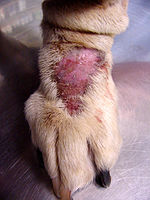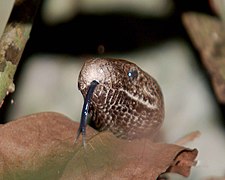Licking
-
A calf licking its nose.
-
A humming bird licking for nectar
-
A male gray kangaroo licking his wrists to thermoregulate
-
Social grooming lions
-
Wolves licking to indicate social status[1]
-
A domestic cat licking its paw during grooming
-
A tiger "licking" the air during the flehmen response
-
A snake licking a leaf to detect prey
Licking is the action of passing the tongue over a surface, typically either to deposit saliva onto the surface, or to collect liquid, food or minerals onto the tongue for ingestion, or to communicate with other animals. Many animals both groom themselves, eat or drink by licking.
In animals
[edit]Grooming: Animals commonly clean themselves through licking. In mammals, licking helps keep the fur clean and untangled. The tongues of many mammals have a rough upper surface that acts like a brush when the animal licks its fur.[2] Certain reptiles, such as geckos, clean their eyes by licking them.[3]
Mammals typically lick their offspring clean immediately after birth; in many species this is necessary to free the newborn from the amniotic sac. The licking not only cleans and dries the offspring's fur, but also stimulates its breathing and digestive processes.[4] Canids also stimulate their pups to urinate by licking their preputial gland secretions.[1]
Food and water acquisition: Hummingbirds are often said to "sip" nectar, but in fact they lap up nectar on their long tongues.[5][6] Their tongues have fringed edges, which help both in nectar-eating and in catching tiny insects. Mother hummingbirds also lick their chicks after a rainstorm to dry them by licking water droplets from the coats of the chicks to avoid them chilling. Many animals drink by licking. While young mammals drink milk from their mothers' teats by sucking, the typical method of drinking for adult mammals involves dipping the tongue repeatedly into water and using it to scoop water into the mouth.[7] This method of drinking relies in part on the water adhering to the surface of the tongue and in part on muscular control of the tongue to form it into a spoonlike shape.[citation needed] Cattle, horses and other animals lick rocks, salt licks or other objects to obtain mineral nutrients.[8][9]
Gustation: Animals also use their tongues to enhance their sense of smell.[10] By licking a surface or extending the tongue beyond the mouth, molecules are transferred via the tongue to the olfactory receptors in the nose and in some animals, to the vomeronasal organ. In some mammals, the tongue is used to "lick" the air during the flehmen response to assist transfer of pheremones. Similarly, snakes use smell to track their prey. They smell by using their forked tongues to collect airborne particles, then passing them to the vomeronasal organ. They keep their tongues constantly in motion, sampling particles from the air, ground, and water, analyzing the chemicals found, and determining the presence of prey or predators in the local environment.[11]
Communication: Dogs and cats use licking both to clean and to show affection among themselves or to humans, typically licking their faces.[12] Many animals use licking as a submissive or appeasement signal in dominance hierarchies.[13][14]
Thermoregulation: Some animals use licking to cool themselves. Cats do not sweat the way humans do and the saliva deposited by licking provides a similar means of evaporative cooling.[15] Some animals spread saliva over areas of the body with little or no fur to maximise heat loss. For example, kangaroos lick their wrists and rats lick their testicles.[16][17]
Mating behavior: Male mammals often lick the genitals of females before copulation.[18] Post-copulatory genital grooming often occurs in male rats and prosimian primates.[19] This behavior may prevent disease transmission.[20][21]
In primates
[edit]Ring-tailed lemurs lick each other's babies as a means of collective grooming and of reinforcing social cohesion within the community.[22] Macaques and other primates lick leaves for water in addition to dipping their arms into tree crevices and licking the water off.[23] Chimpanzees use licking in a variety of ways: licking objects, such as dead trees, that others in their community have licked,[24] licking each other's body parts for grooming and sex[24] and licking rocks for salt.[25] Gorillas use licking in addition to other senses to determine the nature of an object.[26]
In humans
[edit]Compared to most other mammals, licking has a minor role for humans. The human tongue is relatively short and inflexible, and is not well adapted for either grooming or drinking. Instead, humans prefer to wash themselves using their hands and drink by sucking or pouring fluid into their mouth. Humans have much less hair over their skin than most other mammals, and much of that hair is in places which they cannot reach with their own mouth. The presence of sweat glands all over the human body makes licking as a cooling method unnecessary.
Nonetheless, licking does play a role for humans. Even though humans cannot effectively drink water by licking, the human tongue is quite sufficient for licking more viscous fluids. Some foods are sold in a form intended to be consumed mainly by licking, e.g. ice cream cones and lollipops. Though useful, in some cultures it is considered improper table manners to clean one's fingers by licking during a meal.
Some people in the Afar tribe of Ethiopia have been reported to have used their tongues to lick other humans, as a way of cleaning them from the dust that accumulates on them in a very water-scarce region.[27][failed verification]
Humans use licking for a number of other purposes. For example, licking can moisten the adhesive surfaces of stamps or envelopes. Many people lick a fingertip (usually the one of the index finger) for some extra grip when turning a page, taking a sheet of paper from the top of a pile or opening a plastic bag. In sewing, thread ends are commonly wet by licking to make the fibres stick together and thus make threading them through the eye of a needle easier. Another practice considered uncivilized is licking one's hand and using it to groom one's hair.
Humans also use their tongues for sexual purposes, such as during cunnilingus, anilingus, fellatio, breast licking,[28] foot licking, and whilst French kissing, where two people lick each other's tongues.
In dogs
[edit]Abnormal licking
[edit]
Self-licking can sometimes become abnormally frequent[31] occasionally resulting in a lick granuloma. The most common cause of lick granuloma appears to be psychological, related to stress, anxiety, separation anxiety, boredom, or compulsiveness.[32] Lick granulomae are especially seen in active dogs left alone for long periods of time. One theory is that excessive licking causes endorphin release, which reduces pain and makes the dog feel temporarily euphoric. This provides the animal with positive feedback from the licking, and subsequent addiction to the behaviour.
Animals in captivity sometimes develop a licking stereotypy during which surfaces (walls, bars, gates, etc.) are repeatedly licked for no apparent reason. This has been observed in captive giraffes and camels.[33][34]
References
[edit]- ^ a b L. David Mech; Luigi Boitani (1 October 2010). Wolves: Behavior, Ecology, and Conservation. University of Chicago Press. ISBN 978-0-226-51698-1.
- ^ "Pourquoi les chats ont-ils une langue râpeuse ?". www.20minutes.fr (in French). 2023-04-02. Retrieved 2024-06-06.
- ^ "Râpeuse, extensible, bifide ou adhésive : quatre langues extraordinaires". Le Monde.fr (in French). 2023-12-18. Retrieved 2024-06-06.
- ^ "How Do I Know When My Zebra Finch Bird Is Pregnant?". Sciencing. Retrieved 2024-06-06.
- ^ Roberts, W. Mark (1995-04-01). "Hummingbird Licking Behavior and the Energetics of Nectar Feeding". Department of Zoology, University of British Columbia. 112 (2): 456–463. Retrieved 2024-06-06.
- ^ "Nectar feeding beyond the tongue: hummingbirds drink using phase-shifted bill opening, flexible tongue flaps and wringing at the tips".
- ^ "Tree trunks take a licking as koalas source water". The University of Sydney. Retrieved 2024-06-06.
- ^ Macas-Pogo, Patricio; Sánchez, María Cristina Osorio (2021-09-17). "Use of mineral licks by mammals in areas of the Amazonia with no hunting pressure". THERYA (in Spanish). 12 (3): 599. doi:10.12933/therya-21-1086. ISSN 2007-3364.
- ^ "Wildlife Habitat Features Field Guide (Kootenay Boundary Region)" (PDF).
- ^ Universalis, Encyclopædia (1999-01-19). "GUSTATION". Encyclopædia Universalis (in French). Retrieved 2024-06-06.
- ^ AnimalSmart.org. "Do Snakes Really Smell with their Tongues". Default. Retrieved 2024-06-06.
- ^ "Why Does My Dog Lick My Hands When I Pet Her?". www.pinegroveveterinaryhospital.ca. 2024-02-21. Retrieved 2024-06-06.
- ^ "TPWD: Chemical Communication -- Young Naturalist". tpwd.texas.gov. Retrieved 2024-06-06.
- ^ Uccheddu, Stefania; Pierantoni, Ludovica; Ventura, Laura; Gambolo, Luca; Tonna, Matteo (January 2024). "Obsessive compulsive/compulsive disorder in companion animals: An ethological approach". Journal of Veterinary Behavior. 71: 57–62. doi:10.1016/j.jveb.2023.12.003. ISSN 1558-7878.
- ^ Cats and Kittens Magazine, Frequently Asked Cat Questions: Behavior Archived April 22, 2006, at the Wayback Machine. URL visited 8 April 2006.
- ^ "Foreleg Licking Cools Skin — Biological Strategy — AskNature". asknature.org. Retrieved 2024-06-06.
- ^ "Feeling the heat? Here's how some of Australia's most iconic animals keep cool". ABC News. 2023-12-08. Retrieved 2024-06-06.
- ^ Naguib, Marc (2020-04-19). Advances in the Study of Behavior. Academic Press. ISBN 978-0-12-820726-0.
- ^ Peter M. Kappeler; Carel P. van Schaik (13 May 2004). Sexual Selection in Primates: New and Comparative Perspectives. Cambridge University Press. ISBN 978-1-139-45115-4.
- ^ Frans B. M. De Waal; Peter L Tyack (June 2009). Animal Social Complexity: Intelligence, Culture, and Individualized Societies. Harvard University Press. ISBN 978-0-674-03412-9.
- ^ Hart, B. L.; Korinek, E.; Brennan, P. (1987). "Postcopulatory genital grooming in male rats: prevention of sexually transmitted infections". Physiology & Behavior. 41 (4): 321–325. doi:10.1016/0031-9384(87)90395-7. ISSN 0031-9384. PMID 3432385.
- ^ Primate Factsheets: Ring-tailed lemur (Lemur catta) Behavior. Pin.primate.wisc.edu. Retrieved on 2013-03-30.
- ^ Laboratory Primate Newsletter Volume 32 Number 1. Brown.edu. Retrieved on 2013-03-30.
- ^ a b
楽天 が運営 するポータルサイト : 【インフォシーク】Infoseek Archived 2006-04-09 at the Wayback Machine. Mahale.web.infoseek.co.jp (2000-01-01). Retrieved on 2013-03-30. - ^ Week Five. Personal.umich.edu (1996-10-09). Retrieved on 2013-03-30.
- ^ Film Footage Search Results. lastrefuge.co.uk
- ^ African People & Culture. africaguide.com.
- ^ Pakpahan, Cennikon; Darmadi, Darmadi; Agustinus, Agustinus; Rezano, Andri (2022-07-21). "Framing and understanding the whole aspect of oral sex from social and health perspectives: a narrative review". F1000Research. 11: 177. doi:10.12688/f1000research.108675.3. ISSN 2046-1402. PMC 9377381. PMID 36035886.
- ^ a b c Coren, Stanley (2012). How To Speak Dog. New York: Simon and Schuster. ISBN 9781471109416.
- ^ Rugaas, Turid (2006). On talking terms with dogs : calming signals (2nd ed.). Wenatchee, Wash.: Dogwise Pub. ISBN 1929242360.
- ^ "Obsessive-Compulsive Behavior: Chewing, Licking, Fur-Pulling". About.Com. Retrieved September 10, 2013.
- ^ Uccheddu, Stefania; Pierantoni, Ludovica; Ventura, Laura; Gambolo, Luca; Tonna, Matteo (January 2024). "Obsessive compulsive/compulsive disorder in companion animals: An ethological approach". Journal of Veterinary Behavior. 71: 57–62. doi:10.1016/j.jveb.2023.12.003. ISSN 1558-7878.
- ^ "Zoochosis". Circus Watch W.A. Archived from the original on September 4, 2013. Retrieved September 10, 2013.
- ^ Video of a giraffe licking wall





![Wolves licking to indicate social status[1]](https://upload.wikimedia.org/wikipedia/commons/thumb/6/6e/Real_love%21%21_%284294586131%29_%282%29.jpg/270px-Real_love%21%21_%284294586131%29_%282%29.jpg)


